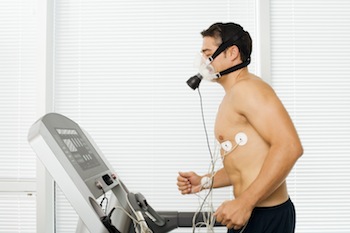The Limitations of VO2 Max for Athletes

VO2 max is considered to be a vital component of any endurance athlete's plan. Simply put, it is the maximum amount of oxygen that an athlete can use in one minute per kilogram of body weight measured while breathing at sea level, explains Body Results (side note: it is impossible for anyone to utilize all the oxygen in the bloodstream at any one time).
As oxygen consumption is correlative to energy expenditure, VO2 max is a measure of an athlete's maximal capacity to work aerobically. The better an athlete's cardiovascular condition, the higher his or her VO2 max value. Therefore, knowing ones VO2 max, and testing for adaptations periodically, can help detect improvements in fitness.
Difficulties in Testing
To increase VO2 max, an athlete must know his or her current value, and here the problems begin to arise. A typical test measures heart rate, speed and breath while running on a treadmill, explains Core Running; however, this type of test requires a large amount of laboratory equipment and expense- testing can cost anywhere from $100 to $200 in a process that can be quite uncomfortable.
The main problem with VO2 max testing in the lab is that the various protocols may yield different results for the same athlete working out using the same exercise, whereas one would expect an accurate physiological test should result in the same values every time.
In the face of these difficulties, many athletes resort to estimating VO2 max by basing the value on the pace they can hold for 10 minutes while exercising at full intensity, reports 10K Running.
This approach, however, has a number of problems of its own. Self-administered tests require extreme self-discipline in order to push to the max; as such, their results are never as accurate as those of lab tests. Moreover, athletes often skew VO2 max values by knowing when the test is going to end.
Limitations for Training
VO2 max as a value, even when accurate, still has a number of limitations for training purposes. VO2 max does not offer the athlete any metabolic feedback, such as that obtained from blood lactate and muscle oxygen saturation (SmO₂) testing.
In addition, VO2 max measures the respiratory system to determine the amount of oxygen the entire body can use; this limitsVO2 max’s efficacy when training localized physiological systems. VO2 max is simply an overall value that divides exertion into training speed, power and endurance rather than testing specific adaptive systems such as muscle, cardio, respiratory.
Regarded my many as an indispensable training metric, VO2 max does have significant limitations. By recognizing these issues, athletes and coaches can adapt their training regimens accordingly.
Follow @MoxyMonitor

